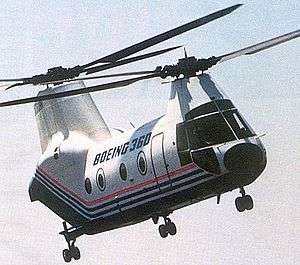Boeing Model 360
| Boeing Model 360 | |
|---|---|
 | |
| Role | Experimental Helicopter |
| National origin | United States |
| Manufacturer | Boeing Helicopters |
| First flight | June 10, 1987 |
| Status | Retired |
| Primary user | Boeing Helicopters |
| Produced | 1987 |
| Number built | 1 |
|
| |
The Boeing Model 360 was an American experimental medium-lift tandem rotor cargo helicopter developed privately by Boeing to demonstrate advanced helicopter technology. The aircraft was intended as a technology demonstrator, with no plans to put the type into production, and many of its design features were carried onto other programs including the RAH-66 Comanche and V-22 Osprey. The sole prototype now resides at the American Helicopter Museum in West Chester, Pennsylvania.
Design and development
Boeing Vertol developed its Model 360 in the 1980s as a technology demonstrator with company funds. It was a new design and made significant use of composites.[1]
The Boeing Model 360 differed from its brethren CH-46 and CH-47 tandem rotor helicopters by incorporating extensive amounts of composite materials in structural and dynamic components, namely in advanced rotor heads composed of fiberglass and graphite composites along with graphite fuselage frames and longerons. The exterior of the craft integrated a Nomex core surfaced by a Kevlar woven mesh with graphite strengthened edges. The two tandem four-bladed contra rotating rotors are each driven by Avco Lycoming AL5512 turboshaft engines mounted on either side of the rear fuselage. In another departure from its military brethren, the Model 360 has no external sponsons containing the landing gear or fuel, the tricycle landing gear instead retracting into the main fuselage. Fuel was contained in three crashworthy cells below the cabin floor.
The Model 360 featured a glass cockpit with six multi-function displays (MFD).[1]
Specifications
Data from Jane's All The World's Aircraft 1988–89[2]
General characteristics
- Crew: 2 pilots
- Length: 51 ft 0 in (15.54 m)
- Rotor diameter: ()
- Height: 19 ft 4¾ in (5.91 m)
- Max. takeoff weight: 30,500 lb (13,835 kg)
- Powerplant: 2 × Avco Lycoming AL5512 turboshaft, 4,200 shp (3,132 kW) each
Performance
- Maximum speed: 200 knots (230 mph, 370 km/h) ; "Dash" speed
- Cruise speed: 180 knots (207 mph, 334 km/h)
See also
- Related development
References
- Taylor, John W. R. Jane's All The World's Aircraft 1988–89. Coulsdon, UK: Jane's Defence Data, 1988. ISBN 0-7106-0867-5.
External links
- Boeing 360 on Janes Aircraft
- Ground Shake Test of the Boeing Model 360 Helicopter Airframe, NASA, March 1989, Retrieved Dec 12, 2008
- N360BV Prototype on Airliners.net